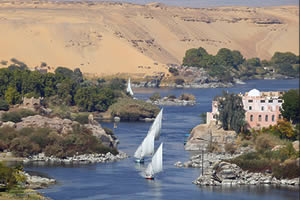Egypt, one of mankind’s most fascinating civilizations emerged around 5000 B.C. at the heart of the northeastern African desert. Today, the pyramids of Cheops, Chepren and Mycerinus welcome visitors to a country that has barely changed along its many centuries of existence.
Modern Egypt is the most populated of all Arab countries, with approximately 74 million inhabitants. It is bounded to the north by the Mediterranean Sea, to the east by Israel and the Red Sea, to the south by Sudan and to the west by Libya. Cairo, the capital, is the most populated city on the African continent, with 16 million souls.
Egyptians are a fairly homogeneous group, with Mediterranean (Greeks and Italians, for example) and Arab influence throughout the territory; they still maintain their cultural bonds with old Egyptian society, which has traditionally been regarded as rural and more numerous than the populations of the neighboring countries.
The government’s struggle
The United Kingdom granted Egypt its independence on February 28, 1922. Today the multiparty democracy dominated by the National Democratic Party, to which current president Hosni Mubarak belongs, is struggling to stop the rise of terrorist activity promoted by Islamic fundamentalists.
The government has based its efforts to curb terrorism on campaigns to the community and the approval of special laws; The current state of affairs seems to indicate it has won the battle, but the previous terrorist attacks on foreign tourists (October 2004) have inevitably hurt tourism, the country’s main industry and source of income. Fortunately, this tendency has been successfully reversed over the last few years.
Economic resources
Since ancient times, agriculture has been the heart of Egypt’s wealth, as fields were fertilized with silt (a sediment similar to sand) deposited by the Nile’s annual floods. There are also oil and gas deposits, but tourism remains the most exploited industry, with close to seven million visitors from around the world who come every year to admire the pyramids and relics of this beautiful civilization.
In recent years, however, natural resources have quickly dwindled due to the quick demographic growth and the erosion of arable land. Pollution from the oil industry has taken a big toll on coral reefs, beaches and the marine habitat, while non-treated wastewater and industrial and agricultural residues have contaminated potable water.
Egyptian culture
Besides tourist attractions like the pyramids, Egypt has several museums, one of the most important being the National Museum of Cairo, also known as the National Museum of Egyptian Antiquities, which houses a vast collection of relics and objects of all the periods of this civilization.
Another main cultural center is the New Library of Alexandria, which opened in October 2002. With its contemporary infrastructure, the library was inspired in the most famous library of the ancient world located in Alexandria. It keeps more than eight million books on different civilizations, science, technology, art and humanities.
Geography and climate
Egypt comprises two clearly distinct zones: the fertile lands along the Nile that concentrate most of the population and agricultural activity, and the Libyan desert located west of the river that extends to the Libyan border.
The desert climate brings little rainfall to the southern part of the country. Summers are hot and dry, both in the desert as well as in the Nile Valley. Winter, autumn and spring are therefore the best seasons for a visit.








